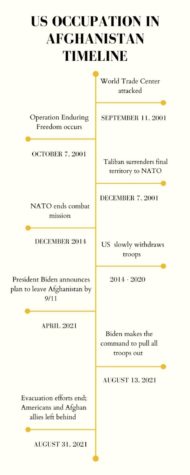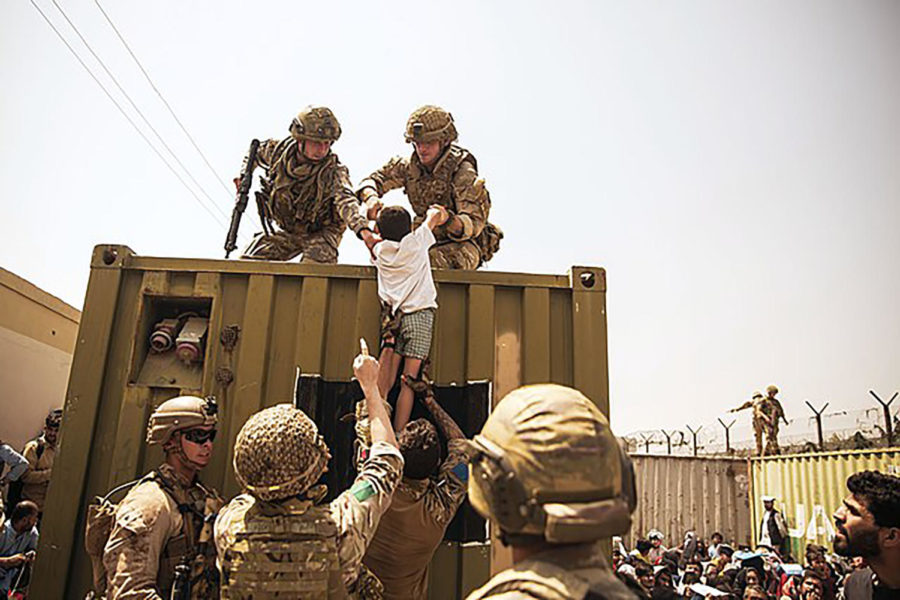Crisis Unaverted
As America’s 20 year military presence in Afghanistan comes to an end, the resulting crisis casts a questionable shadow over the nation’s foreign policy.
American soldiers help lift a young Afghan boy on to a military vehicle amid the Kabul evacuations. Photo courtesy of Wikimedia.
Blood runs hot in American citizens and service members as the remains of the red, white, and blue trickle down the side of a former United States Embassy in Afghanistan, replaced with colors of terror and death. Americans left in the now terrorist-controlled country hide behind locked doors, terrified that their home will be the next one rampaged. Afghan women plead for help as their rights are stripped away one by one under the new regime. Men and women who allied themselves with the United States and other NATO countries count their breaths, praying for mercy as terrorists hunt them down, one at a time.
The Biden Administration’s decision to withdraw all US forces from Afghanistan was a primary factor that caused the humanitarian crisis we are now witnessing. The Taliban, a terrorist group resurrected, now control the petrified citizens left behind.
For the past 20 years, the United States has had a military presence in the middle-eastern country. The decision to invade followed the Taliban’s refusal to hand over infamous terrorist leader Osama Bin Laden.
Bin Laden, who belonged to the terrorist group Al Qaeda, was responsible for the attacks on the World Trade Center and Pentagon on September 11, 2001. After he launched these attacks, Bin Laden found refuge within the Taliban lands, according to cfr.org.
Former President George W. Bush demanded that the Taliban give the United States military the names of all Al Qaeda leaders or risk being fired upon. The Taliban refused, resulting in the United States launching Operation Enduring Freedom, which consisted of a long string of military strikes on both Al Qaeda and the Taliban on October 7, 2001, according to npr.org.
“The world has come together to fight a new and different war, the war on terrorism. First, and we hope the only one, of the 21st century. A war against all those who seek to export terror, and a war against those governments that support or shelter them,” announced Bush on October 11, 2001 following his declaration of war on terrorism.
For twenty years, the United States and its allies fought to keep the Taliban subdued. 2,448 American veterans died in combat, and 2.2 trillion dollars were poured into Afghanistan, according to AP news and the Daily Wire.
President Joe Biden announced in April that he was making plans to withdraw U.S. troops from Afghanistan by September 11, 2021, but those plans changed.
On August 13, 2021, the worlds’ jaws collectively dropped. President Biden made the command to remove all US troops from Afghanistan, originally planning on keeping only a few Americans within the country’s borders.

“The embassy remains open and we plan to continue our diplomatic work in Afghanistan,” Ned Price, the U.S. Department of State spokesperson announced.
“The United States will continue to support consular services, and that includes the processing and operations of the Special Immigrant Visa program, and will continue to engage in diplomacy with the Afghan Government and the Afghan people. Additionally, we will continue our focus on counter-terrorism.”
A few days later, however, the decision was made to pull out all U.S. troops and citizens by the new deadline, August 31. Chaos ensued as Americans, Afghan citizens and allies swarmed the Hamid Karzai Airport.
“Since the evacuation operation began on August 14, more than 123,000 people, most of them Afghans, have been evacuated, according to the U.S. government,” Gibson Dunn, a nationally-renowned law firm, reported, as of September 9th.
It is estimated that the number of American citizens still left in Kabul is around 200, according to the Daily Wire. The actual number could be higher, given there are many undocumented Americans still there as well.
During the Afghan evacuations, many events occurred that directly affected Americans. One of these events was the killing of 13 US service members, including 11 marines, one army staff sergeant, and a navy medic, according to NPR.
“The attack, by at least two suicide bombers, struck at the only avenue of escape for the thousands of foreign nationals and tens — or hundreds — of thousands of their Afghan allies who are trying to flee the country following the Taliban takeover and ahead of the final withdrawal of U.S. troops,” the New York Times reported.
This attack marked the deadliest military strike on Americans since February 2020.
“This tragedy should never have been allowed to happen, which makes our grief even deeper and more difficult to understand,” former President Donald Trump said in a statement made a few days after the attacks.
This appalling attack is in addition to many other tragedies. Photos and videos have been released showing desperate Afghans clinging to the sides of airplanes midair, crowds of men, women, and children fighting to get onto planes, and sobbing girls begging army personnel to take them with them. These appalling images show what Afghanistan is like, now that the United States is gone.
“We just smell the death. I’m afraid to let [the children] go out, or myself to go out, an American woman left in Afghanistan told CNN, after the August 31st deadline passed. She and 37 other Americans, including children, are all living together, fearing for their lives.
“This is my fear that if American could not help me, when they were on the ground, how will they help me now, when there no one is here? That’s my question.”
The horrors occurring in Afghanistan have not been without moments of joy.
“A flight with American citizens and lawful permanent residents that departed Afghanistan on [September 9th] safely landed in Qatar,” Fox News reported. (Qatar is another middle-eastern country located on the coast of Saudi Arabia and shares no borders with Afghanistan.) This successful evacuation signals the beginning of the government’s promise to get all American citizens out of Afghanistan, regardless of any deadlines.

“As President Biden has said, if you are an American citizen who wants to leave Afghanistan, there is no deadline,” Emily Horne, National Security Council spokesperson, said. “We remain committed to get them out if they want to come out.”
What has occurred in Afghanistan is an unforgettable moment that will go down in history. And as the Taliban government is set up and Afghans prepare for the worst, the future is uncertain for America, Afghanistan, and foreign policy.







